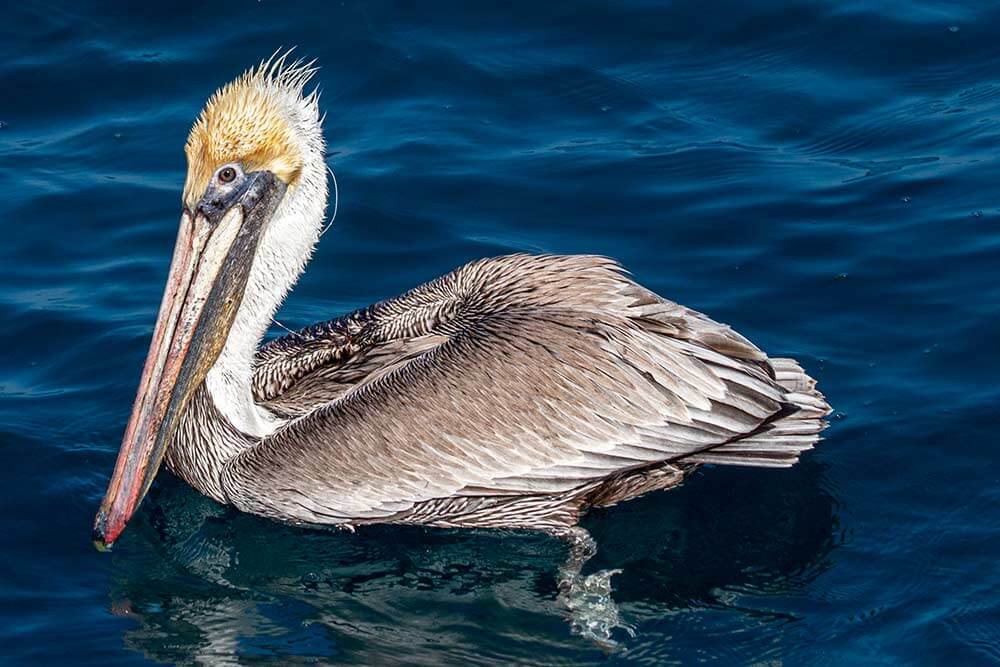Recreational Fishing Line and Bird Bycatch

Today, we would like to tell you a little story. As you read the words below, we ask you to place yourself on the water’s edge and join us on a journey by the sea. Here we go….
You cast out your various types of fishing line as you stand upon the jetty just above the sea wall, the wind in your hair and the glow of the setting sun before you. The thrill of hooking a big fish keeps you glued to the water. An alternate reality soon sets in and your once limp line is now taut, you did it! You arch yourself backward pulling and tugging, doing everything in your power to reel your big fish in. Your fight begins to feel more like a struggle and you realize you are not winning the battle with the fish, and instead, your hungry fish is a series of underwater rocks. Your line has become stuck, wedged between the rocks. You have to cut your losses, sever the line of hopeful dinner dreams and trophy fish. If time permits, this cycle repeats itself day in and day out.
This all too familiar anecdote is a common story told on every coastline and riverbed and lake, in every region, and this storyline has been romanticized for centuries everywhere in the world.
The fisherman (or woman) either catches a fish or goes home empty-handed and the different types of fishing line remain in the water or shoreline, indefinitely. By nightfall, the person fishing has long since left for home. And, as the tide continues to ebb and flow, the fishing line unintentionally continues to catch things in its path. The monofilament line or fluorocarbon fishing line loops itself around the edges of jagged rocks, seemingly unable to be freed and the useless line to the fisherman or woman is now free-floating in the water as he or she heads home for the day. The night quickly grows darker. The birds who live in nearby colonies begin to make their journey home from sea to the same jetty the fisherman (or woman) was before. Tonight, for the birds, their landing back home is also the potential start of their fearful and pending demise. The cut fishing line left behind by fishermen during the day has now become what could be a death trap.
The line that felt free to the person fishing is now connected to both feet (or the wing, or neck or feathers) of what could be California brown pelican or pacific gull or Bryant’s cormorant. The various types of fishing lines become wrapped around the bird’s feet, not allowing flight or the ability for the bird to swim away from the already imposing danger. Perhaps the unsuspecting bird has taken the bait from the unused hook, or brushed up against the now naked hook and become snared. The next moments immediately and drastically change from a fluffy feathery return home to a death trap of fishing line entanglement.

This sad tale is something that happens all too often across coastlines everywhere in the world. In Dana Point, CA, it’s not only the various fishing line types doing detrimental damage but also hooks and lures. Fishing hooks pose a great risk to these high-flying beauties. Once ingested, hooks can destroy the side of a bird’s beak or could become lodged inside their mouth, esophagus, or stomach leading to internal bleeding and destructive tissue damage, or even death. If a bird’s stomach becomes compromised, it could have trouble keeping food down, finding itself regurgitating food causing malnourishment and potential risk of death.
When trying to escape fishing line types of all colors, lengths, and weights, the question now becomes, “What happens when your second chance becomes your last shot?”
There is a multitude of different types of fishing lines improperly disposed of along beaches that have been thrown over from boats into the water or have been left tangled upon the rocks and kelp beds. These useless lines to humans for fishing, become death traps for all kinds of birds, crustaceans, and cetaceans. Whether it is a fluorocarbon fishing line, monofilament line, or braided line, these all are intended to catch fish, not birds. Each can play a toxic role in creating a detrimental environment for animals of all shapes and sizes living close by. Most people who fish never even realize that the fishing line types they use are also hurting animals. Carelessly discarded fishing lines and hooks can wreak havoc on the birds themselves but also on the habitats in which they dwell. As with anything that becomes entangled, birds can suffer a painful attempt at an escape once tangled up.

Once entangled, the fishing line types mentioned above can not only apply severe pressure around feet, necks, and wings but can cause permanent damage to nerves and bones, skin, and feathers too. When an adult bird becomes compromised by various fishing line types, the result can be catastrophic for their young too. If parents cannot swim or fly, they are also not able to forage for nearby food. The result of the lethal tangle could lead to potential malnourishment and even the death of young chicks. Captain Gary, of Capt. Dave’s Dolphin and Whale Watching Safari, has been spending his free time trying to make changes in the Dana Point Harbor and takes weekly trips out on his kayak, cleaning up the rocks and jetty. Recently he has begun bi-weekly clean-up alongside the Dana Point Harbor jetty.
“My main goal is to educate the fishermen to not leave fishing line and hooks on the jetty because it entangles birds and other animals. And to discard it in the white recycling tubes that are located in all of the jetty fishing spots. If they put the fishing line in a regular trashcan it will go to the dump and entangle birds at the dump. So, it is crucial to put it in the recycling tubes.” – Captain Gary Brighouse, Captain Dave’s Whale Watching Captain.
We know that everyone in your community may not have the same kind of available time or access to kayaks like our very own Captain Gary. There are still easy ways to become involved and do your part to help birds in your area from being harmed by all of these fishing line types. Word of mouth is the most powerful form of advertising. Educate!
Spread the word to non-fishermen and women to please pick up any fishing line types that need to be discarded. Right here in Dana Point, CA, if there happens to be a line secured around rocks or lying on the ground, it can be placed into the white recycling tubes that are stationed along the Dana Point Harbor. Oftentimes there is inadequate signage to let fishermen and women know that the white recycling tubes along the shoreline and near jetties are for recycling all types of fishing line. In many cases, the simple step of just picking up the discarded line could save countless lives!
Here are a few more ideas you can put into action today!
- Notify our local newspapers so they can maximize awareness of the issue.
- Tap into local recycling and our volunteer efforts, maybe even create your own monthly clean-up effort!
- Social media is powerful! Create and share videos on social media channels like Twitter, Instagram, Facebook, and TikTok.
- Request proper signage from your local city government so that your community can recycle all fishing lines types properly.
- Talk to your local fishing license application agencies and encourage agencies to provide line disposal and recycling information to all fishing license applicants.
Thank you for tuning in!
Until then,
Jess Wright
First Mate and Marine Naturalist
Capt. Dave’s Dolphin & Whale Watching Safari
